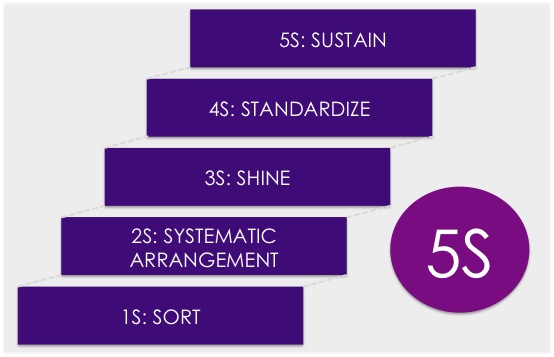5S Principles
5S is a method to improve and sustain workplace organisation. 5S represents 5 disciplines for maintaining a visual workplace (visual controls and information systems).These are foundational to continual improvement and a manufacturing strategy based on “Lean Manufacturing” (waste removing) concepts.
5S help reduces clutter, reduces the time it takes to look for tools and equipment. Improves how the operation appears to customers – always be “tour ready”. Creates pride in the workplace. Many companies have a standard that any tool must be able to be found within 60 seconds.
One of the Key Principle of 5S is have
“A place for everything and everything in its place”
5S are 5 Japanese / English words starting from the word S
1S – Sort: Remove all unnecessary materials and equipment: Sort means that you remove all items from the workplace that are not needed for current production (or clerical) operations. Getting rid of items in the workplace can be unnerving. People tend to hang onto parts, thinking that they may be needed for the next order. They see an inappropriate machine and think that they will use it somehow. In this way, inventory and equipment tend to accumulate and get in the way of everyday production activities. This leads to a massive buildup of waste factorywide. In Sorting a “red-tag holding area” is used evaluate the necessity of an item instead of simply getting rid of it. This greatly reduces the risk of disposing of an item that is needed later.
2S – Systematic Arrangement: Make it obvious where things belong. Systematic arrangement can be defined as arranging needed items so that they are easy to use and labeling them so that they are easy to find and put away. Systematic arrangement should always be implemented with Sort. Once everything is sorted through, only what is necessary remains. Next it should be made clear where these things belong so that anyone can immediately understand where to find them and where to return them
3S – Shine: Clean everything, inside and out, generally making sure that everything in the factory stays clean. In a manufacturing company, Shine is closely related to the ability to produce quality products. Shine also includes saving labor by finding ways to prevent dirt, dust, and debris from piling up in the workshop. Shine should be integrated into daily maintenance tasks to combine cleaning checkpoints with maintenance checkpoints.
4S – Standardise: Establish policies and procedures to ensure 5S. Standardize is the method used to maintain the first three pillars-Sort, Set in Order, and Shine. Standards mean best, safest & easiest way to do a particular task. Defining and following standards for first 3S, will help use a systematic approach to 3S implementation and also easily identify any deviations and gaps at time of 5S audit.
5S – Sustain: Sustain means making a habit of properly maintaining correct procedures. First four pillars can be implemented without difficulty if employees commit to sustaining 5S conditions. Such a workplace is likely to enjoy high productivity and high quality. In many factories great amounts of time and effort are spent in vain on sorting and cleaning because the company lacks the discipline to maintain 5S conditions and continue 5S implementation on a daily basis. Even if the company occasionally organizes 5S campaigns and contests, without the Sustain pillar the other pillars will not last long.
Safety (often called “6S” or “5S + 1”)
In East African Language (Kiswahili) – 5S is known as 5K. 5 Kiswahili words starting from the word K.
How to Implement 5S Principles at your workplace?
Implementing 5S at your workplace requires knowledge and skill on understanding systematic approach to implement 5S principles. More often 5S implementation fails because of lack of systematic approach. Many organisations jump to aesthetics by implementing colour coding, signages, boards etc but often fail in long term. Reason for failure is not to following steps in systematic manner. Implementing systematic arrangement first requires removal of all unwanted items, otherwise unwanted items will be taking lot of space and systematic arrangement will not work. another key point of implementing 2nd principle of 5S i.e. systematic arrangement is to follow below steps:
- Decide what items to be kept (Do sorting first!)
- Decide How much to keep: For each time to be kept in work area, quantity to be kept must be defined first. without doing this step, 5s will always fail.
- Decide where to keep: this is done by doing analysis of frequency of usage. items where frequency of usage is very high should be kept nearer to point of use. a Location map can be very useful to finalise on this step
- Decide How to keep: this step should always be done after doing above 3 steps. purpose of this steps is make it easier to take and return items to its storage location. Key principle here is “Make it Obvious”. Each item should be a fixed location marked with color coding, markings, labels or signboards.
Similarly there are many key points in implementing each element of 5S. RIB Consulting can help you learn 5S principles as well as help in implementing 5S at your organisation.



